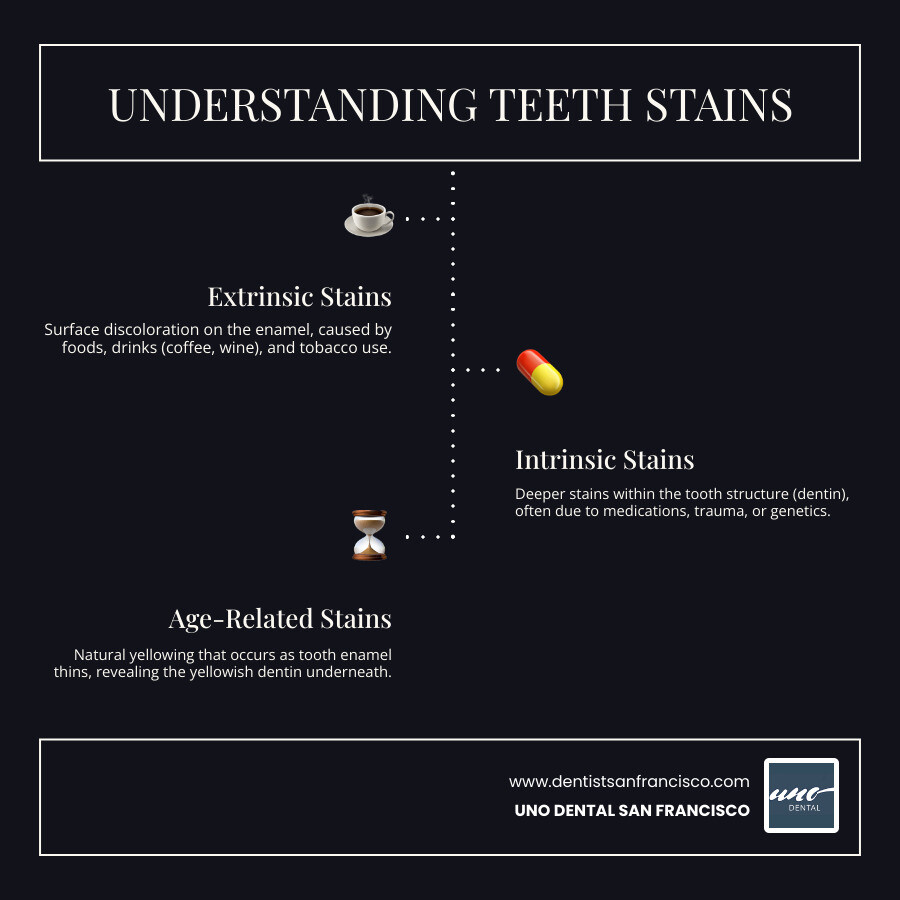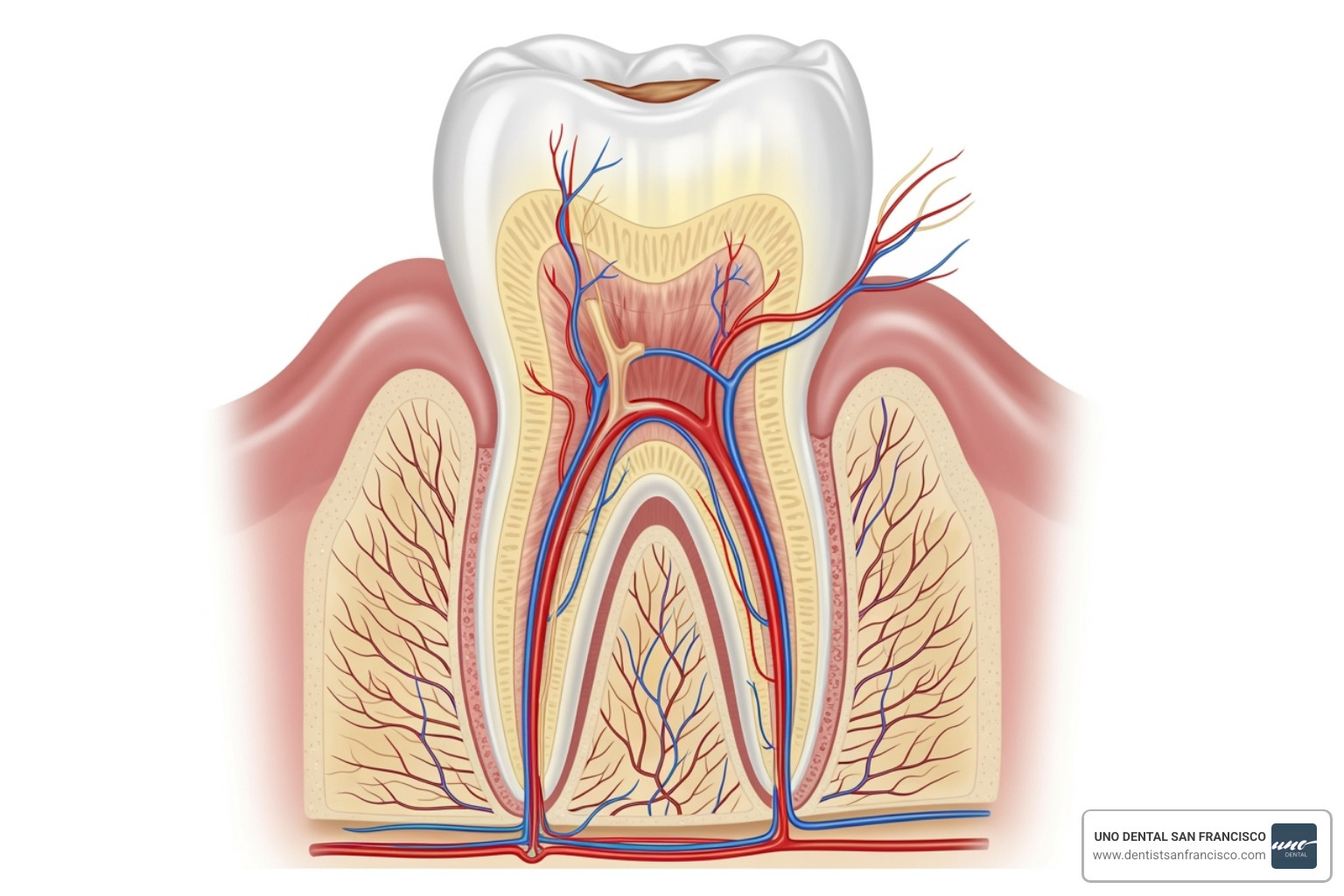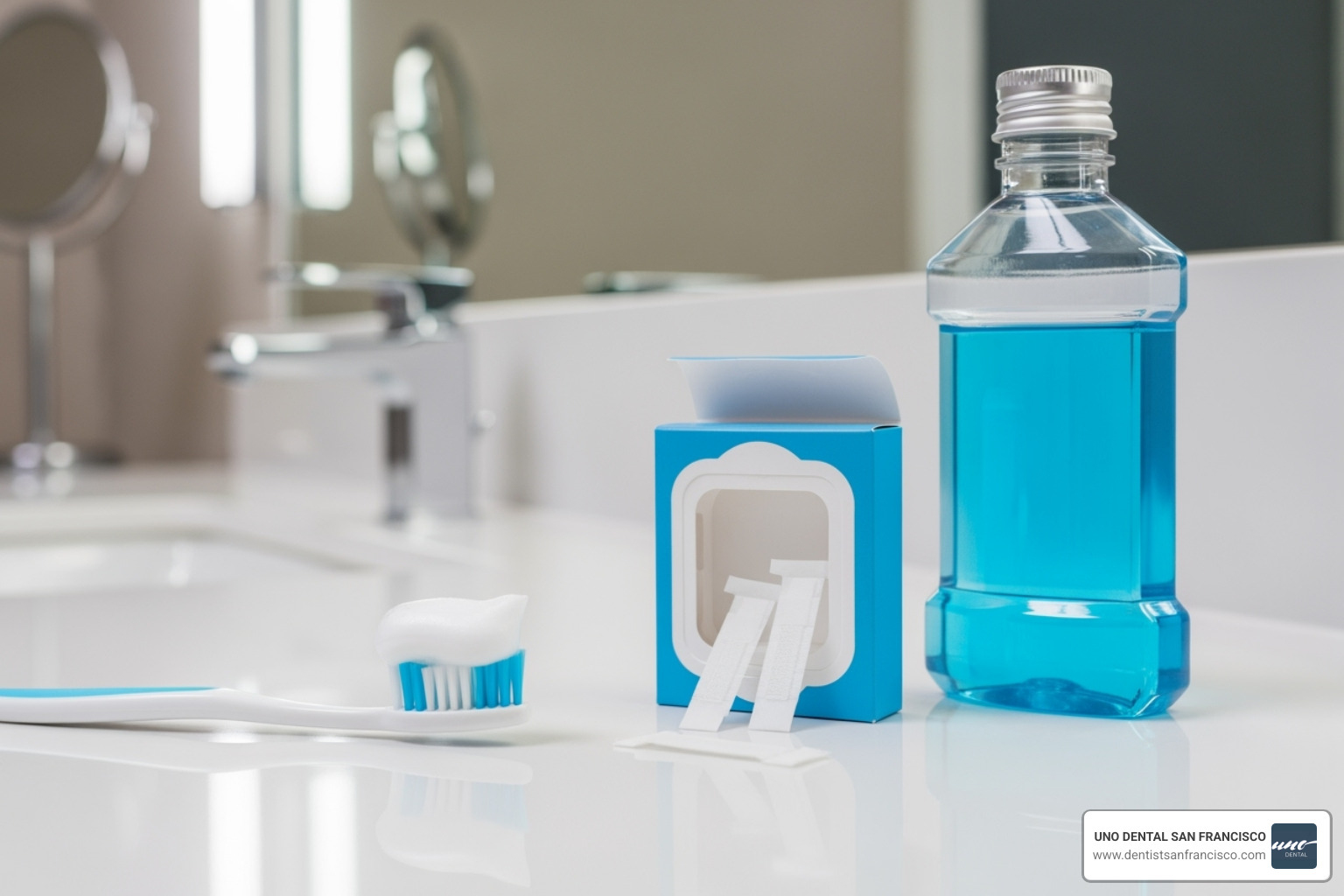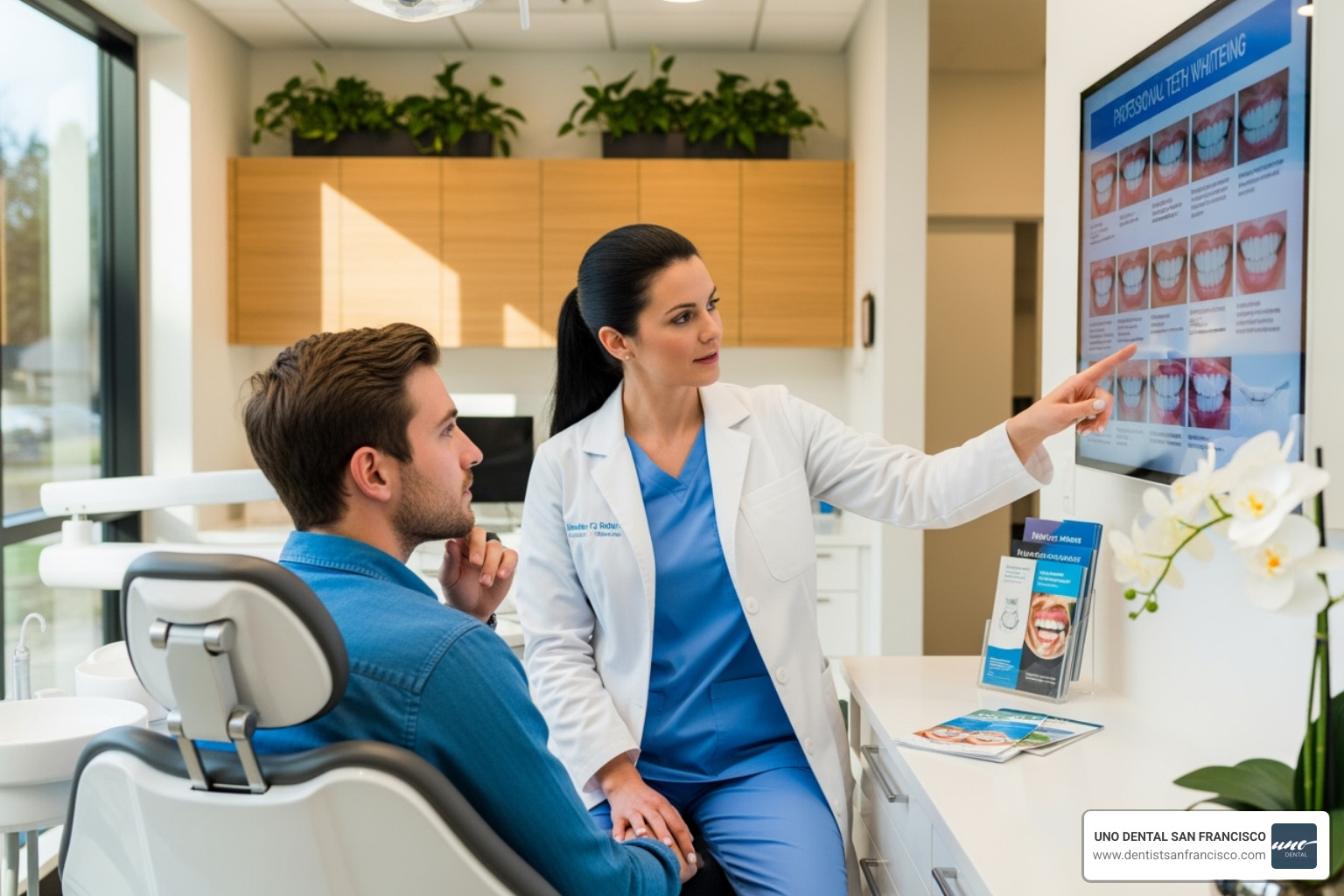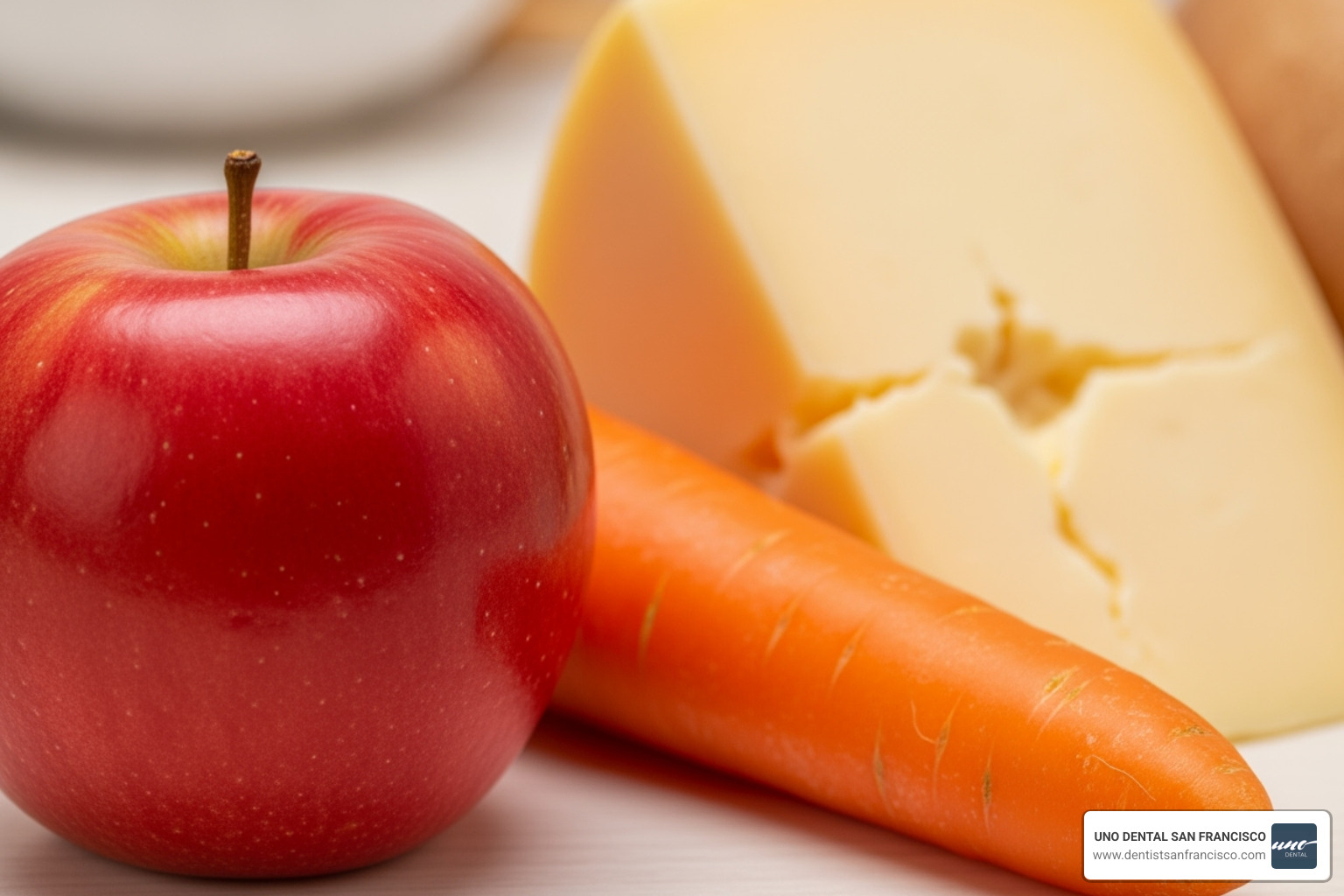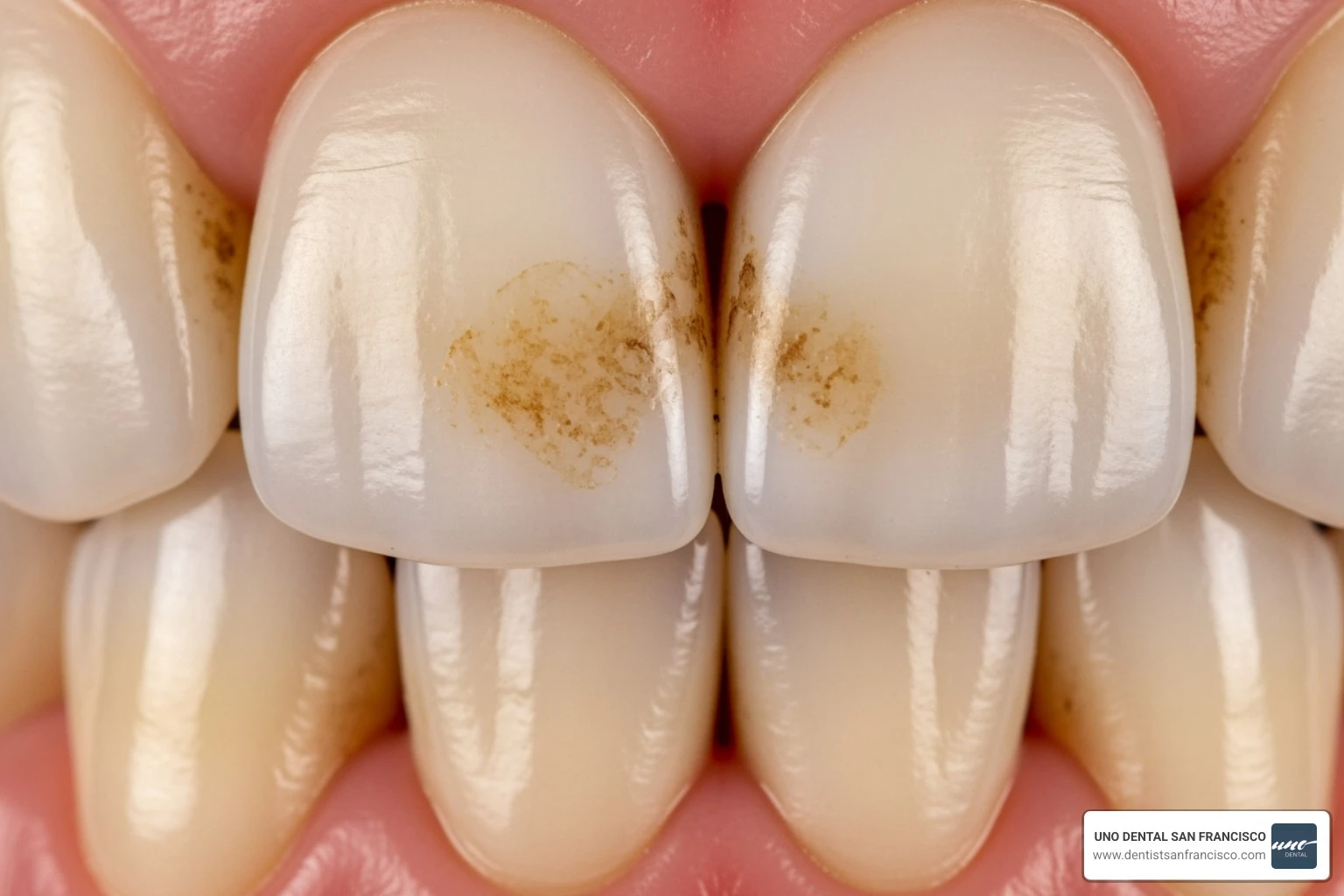
The Science Behind Your Smile: Why Teeth Stains Matter More Than You Think
Reviewed by: Mohammad Aghiad Kandar, DDS (UNO DENTAL SAN FRANCISCO) - September 29, 2025
Learning how to clean stained teeth is one of the most common concerns for adults seeking to improve their appearance and confidence. Here are the most effective methods:
Quick Solutions for Stained Teeth:
- Professional whitening - Most effective for immediate, dramatic results
- Whitening toothpaste - Gradual improvement for surface stains
- Baking soda paste - Natural option (use sparingly to protect enamel)
- Custom dental trays - Professional-grade at-home treatment
- Avoid DIY acids - Skip lemon juice, vinegar, and charcoal methods
Your smile creates powerful first impressions. Research from the American Academy of Cosmetic Dentistry reveals that nearly half of people consider a smile the most memorable feature after a first meeting, while 45% view it as the most attractive feature regardless of age. Even more striking, 54% of people over 50 believe that a smile can best help avoid the visible effects of aging.
Stained teeth affect millions of people despite proper brushing and flossing. The discoloration comes from three main sources: surface stains from foods and drinks, deeper stains within the tooth structure, and natural aging processes that yellow teeth over time.
The good news? Most teeth stains are treatable with the right approach. From gentle at-home methods to professional treatments, you have multiple options to restore your smile's natural brightness.
As Mohammad Aghiad Kandar DDS at UNO DENTAL SAN FRANCISCO, I've helped hundreds of patients understand how to clean stained teeth safely and effectively through both professional treatments and proper at-home care. My 15+ years of experience in restorative and cosmetic dentistry has shown me that the best results come from understanding your specific type of staining before choosing a treatment method.
Understanding Tooth Discoloration: Why Do Teeth Get Stained?
Understanding how to clean stained teeth starts with knowing why they get discolored in the first place. Think of your teeth like a beautiful white shirt - they're strong and durable, but they can pick up stains from what we eat, drink, and do throughout our lives.
Your teeth have a fascinating structure that directly affects how stains develop and how deep they penetrate. Let me walk you through the basics so you can better understand your smile.
The enamel is your tooth's protective outer shell - it's actually the hardest substance in your entire body! This semi-clear layer gives your teeth their shine and protects everything underneath. When enamel is healthy and thick, your teeth look naturally white and bright.
Beneath the enamel lies the dentin, which has a naturally yellowish color. As we age or when enamel wears thin, more of this yellow dentin shows through, making teeth appear darker. It's completely normal, but it's one reason why our smiles change over time.
Plaque and tartar buildup also play a major role in tooth discoloration. Plaque is that sticky bacterial film that forms on your teeth every day (yes, even if you brush regularly!). When plaque isn't removed properly, it hardens into tartar - a rough, porous substance that loves to grab onto stains. This buildup can make your teeth look dull and yellow, which is why regular dental cleanings are so important.
The Three Types of Teeth Stains
Not all stains are created equal, and knowing which type you're dealing with makes a huge difference in how to clean stained teeth effectively. Here are the three main categories:
Extrinsic stains are the surface-level troublemakers. These develop on your tooth enamel from pigments in foods, drinks, and tobacco. The good news? They're usually the easiest to tackle with proper oral care and whitening treatments. That brown film after your morning coffee? That's an extrinsic stain.
Intrinsic stains go much deeper, forming within the tooth structure itself. These can result from certain medications (like tetracycline antibiotics during childhood), too much fluoride, dental injuries, or even genetics. Intrinsic stains are stubborn - they typically need professional treatment or cosmetic solutions to address effectively.
Age-related stains combine both types over time. As your enamel naturally thins with age, the yellow dentin beneath becomes more visible. Plus, years of exposure to staining substances create layers of discoloration that make your smile appear duller.
For a deeper dive into the complexities of tooth discoloration, visit our detailed guide on tooth discoloration.
Common Causes of Stained Teeth
Let's talk about the everyday culprits behind tooth stains. Understanding these causes helps you make informed choices about prevention and treatment.
Coffee tops the list for many of my patients. Its dark pigments and acidity create the perfect storm for brown and yellow stains. But don't worry - you don't have to give up your daily cup! Smart consumption and proper care can help minimize the impact. Learn more about this relationship in our article Will Coffee Stain Your Teeth?.
Tea, red wine, and dark berries all contain compounds called tannins and chromogens - fancy names for pigment-producing substances that love to stick to your teeth. Soda adds another layer of trouble with its acids and artificial colors that can actually soften your enamel, making it more vulnerable to staining.
Tobacco use creates some of the most stubborn stains I see in practice. Whether smoking or chewing, tobacco penetrates deep into tooth structure, creating brown and yellow discoloration that's particularly challenging to remove.
Poor oral hygiene allows plaque and tartar to build up, creating a rough surface that traps stains like a magnet. This is why consistent brushing, flossing, and professional cleanings are your first line of defense.
Some medications can cause intrinsic staining, particularly tetracycline antibiotics taken during tooth development. Certain mouthwashes containing chlorhexidine can also cause temporary surface stains.
The aging process naturally changes our teeth as enamel thins and dentin darkens over time. Dental trauma from accidents or injuries can cause individual teeth to darken due to internal changes within the tooth.
Finally, genetics play a role too. Just like your hair or eye color, some people are naturally predisposed to having yellower teeth due to their enamel thickness and dentin shade.
Understanding these causes helps you choose the most effective approach for your specific situation when learning how to clean stained teeth safely and successfully.
At-Home Methods for Cleaning Stained Teeth
When you're looking for ways to how to clean stained teeth, your first instinct might be to check your medicine cabinet or kitchen pantry. You're not alone - millions of people start their whitening journey with at-home solutions before considering professional treatments.
The good news is that many over-the-counter products can genuinely help with surface stains. The not-so-good news? Some popular "natural" remedies floating around social media can actually damage your teeth permanently.
Let's separate the helpful from the harmful, so you can make smart choices about your smile.
Whitening Toothpastes and Rinses
Whitening toothpastes are probably the gentlest way to start your journey toward cleaner, brighter teeth. Think of them as your daily maintenance crew - they won't deliver dramatic overnight results, but they'll steadily chip away at surface stains.
These products work in two main ways. First, they contain mild abrasives that act like tiny scrubbers, polishing away the coffee and tea stains that build up on your enamel throughout the day. Don't worry - these abrasives are much gentler than what you'd find in regular household cleaners.
Second, many whitening toothpastes include small amounts of peroxide ingredients like hydrogen peroxide or carbamide peroxide. These are the same bleaching agents dentists use, just in much lower concentrations. They help lighten your tooth shade gradually over time.
A 2018 study on whitening toothpaste efficacy confirmed what we see in our practice - these products are both safe and effective for removing surface stains when used consistently. The key word here is consistently. You'll typically see gradual results over several weeks or months, not days.
Here's a pro tip: using an electric toothbrush with your whitening toothpaste can boost your results. The extra vibration helps the mild abrasives work more effectively against stubborn stains.
For a deeper dive into your at-home options, check out our comprehensive At-Home Dental Whitening Guide.
Baking Soda and Hydrogen Peroxide
Your grandmother might have told you about brushing with baking soda, and it turns out she was onto something. This DIY paste has been helping people clean stained teeth for generations.
Baking soda works as a mild abrasive that scrubs away surface stains without being too harsh on your enamel. It also creates an alkaline environment in your mouth, which makes it harder for stain-causing bacteria to thrive.
Hydrogen peroxide is nature's bleaching agent. It not only helps lighten tooth color but also kills bacteria that contribute to plaque buildup and bad breath.
When you mix these two ingredients into a paste, you get a powerful but gentle whitening treatment. Research on baking soda and peroxide toothpaste shows that people who used this combination saw significant improvements in stain removal after just six weeks.
But here's where we need to talk about enamel safety concerns. While this mixture is effective, its abrasive nature means you shouldn't use it every day. Think of it like using a scrubbing pad on a delicate surface - a little goes a long way, but too much can cause damage.
We recommend using a baking soda and peroxide paste only two to three times per week, and always follow up with a fluoride toothpaste to help strengthen your enamel.
For more detailed information about safe peroxide use at home, visit our guide on At Home Teeth Bleach.
The Truth About "Natural" Whiteners: Charcoal, Vinegar, and Fruit
Now we need to have an honest conversation about some trendy "natural" whitening methods that are all over social media. While they might seem harmless because they're "natural," some of these can seriously damage your teeth.
Activated charcoal has become incredibly popular, with influencers posting dramatic before-and-after photos of their charcoal-blackened smiles. The theory is that charcoal's absorbent properties will "pull" stains right out of your teeth.
Unfortunately, the science doesn't support the hype. Research on charcoal's abrasiveness shows that activated charcoal can be quite harsh on your enamel and any existing dental work like fillings or crowns. The abrasiveness can actually wear away your protective enamel layer, exposing the naturally yellowish dentin underneath - making your teeth look more yellow over time.
Apple cider vinegar is another popular DIY recommendation, but this one makes us particularly nervous. While some people swear by diluted vinegar as a whitening mouthwash, vinegar has a pH of around 2.5 - that's acidic enough to cause serious enamel erosion.
Any liquid with a pH below 5.5 can start dissolving your tooth enamel. Once that protective layer is gone, it's gone forever. The temporary "whitening" effect people notice is actually their enamel being dissolved away - definitely not the result you want.
Fruit acids like those found in strawberries, lemons, and oranges fall into the same dangerous category. You might see suggestions to rub lemon peels on your teeth or make a strawberry-baking soda paste, but these fruit acids can cause permanent damage to your enamel structure.
The one "natural" method that gets our cautious approval is oil pulling. This ancient practice involves swishing coconut, sesame, or sunflower oil in your mouth for 10-20 minutes. While it won't dramatically whiten your teeth, oil pulling can help reduce the bacteria and plaque reduction that contribute to yellowing and staining.
Think of oil pulling as a supplement to your regular oral hygiene routine rather than a whitening miracle cure. It's generally safe, and some people find it helps their overall oral health - just don't expect Instagram-worthy results.
The bottom line? When it comes to how to clean stained teeth naturally, stick with gentle methods like oil pulling and avoid anything acidic that could damage your enamel permanently.
How to Clean Stained Teeth with Professional Help
When you've tried whitening toothpastes and home remedies without success, it might be time to consider professional help for how to clean stained teeth. Professional treatments offer something at-home methods simply can't match: the expertise of trained dental professionals, stronger whitening agents, and customized solutions custom to your specific needs.
The difference between professional and at-home treatments goes beyond just strength. When you visit our team at UNO DENTAL, we start with a thorough evaluation of your teeth and gums. This allows us to identify the type of staining you have and recommend the safest, most effective approach. We can also address any underlying dental issues that might be contributing to discoloration.
Professional treatments offer four key advantages: improved safety through proper application and gum protection, dramatically faster results that can brighten your smile in a single visit, superior effectiveness for stubborn stains that resist home treatments, and complete customization based on your unique dental situation and whitening goals.
In-Office Professional Teeth Whitening
For patients who want immediate, dramatic results, in-office whitening remains the gold standard for how to clean stained teeth professionally. During your appointment, we apply high-concentration bleaching agents directly to your teeth under carefully controlled conditions.
The process typically begins with protecting your gums and soft tissues using a special barrier. We then apply a professional-grade whitening gel containing hydrogen peroxide at concentrations much higher than what's available in store-bought products. Some systems also use light-activated technology to improve the chemical reaction and accelerate the whitening process.
What makes this treatment so effective is the immediate and dramatic results. Many patients see their teeth become several shades lighter in just one session, making it ideal for those with significant staining or anyone preparing for a special event. The entire procedure is performed under professional supervision, which means we can monitor your comfort level and adjust the treatment as needed.
This approach works particularly well for extrinsic stains from coffee, wine, or tobacco use. You can see real examples of these changes in our teeth whitening before-and-after gallery. To learn more about our specific in-office options, visit our San Francisco Teeth Whitening page.
Dentist-Supervised Take-Home Kits
Some patients prefer the convenience and control of whitening at home while still benefiting from professional-grade materials. Our dentist-supervised take-home kits offer exactly this balance.
The key difference between our take-home kits and drugstore options lies in the custom-fit trays. We create these trays from precise impressions of your teeth, ensuring the whitening gel makes even contact with all tooth surfaces while preventing leakage onto your gums. This custom fit eliminates the irritation and uneven results often experienced with one-size-fits-all store-bought trays.
The professional-grade whitening gel we provide contains higher concentrations of active ingredients than over-the-counter products, delivering more noticeable and longer-lasting results. You'll use these trays at home for a specified period each day, following our detailed instructions for optimal safety and effectiveness.
This option appeals to busy professionals who want to whiten their teeth on their own schedule, as well as those who prefer a more gradual approach to teeth whitening. The treatment typically takes one to two weeks to achieve full results, depending on the severity of your staining.
For detailed information about this flexible whitening option, explore our guide to Custom Fit Teeth Whitening Trays.
Cosmetic Solutions for Deep Intrinsic Stains
Sometimes, traditional whitening methods aren't enough. When dealing with deep intrinsic stains caused by medications, trauma, or genetic factors, we need to think beyond bleaching. These situations call for cosmetic solutions that can completely transform the appearance of your teeth.
Dental bonding works well for minor intrinsic stains and small imperfections. During this procedure, we apply a tooth-colored resin material directly to the affected tooth, carefully sculpt it to match your natural tooth shape, and then harden it with a special curing light. The result is an immediate improvement that effectively masks discoloration while maintaining a natural appearance.
For more extensive intrinsic staining or when patients want a complete smile makeover, porcelain veneers offer an exceptional solution. These ultra-thin, custom-made shells bond to the front surface of your teeth, creating a bright, uniform appearance that can last for decades with proper care. Veneers can address not only severe discoloration but also chips, cracks, and minor alignment issues.
In cases where a tooth has been severely damaged or darkened due to trauma or root canal treatment, dental crowns provide the most comprehensive restoration. A crown covers the entire visible portion of the tooth, restoring both its appearance and structural integrity.
These cosmetic approaches represent permanent solutions for patients who haven't achieved their desired results with traditional whitening methods. To explore these advanced options further, visit our Cosmetic Dentistry San Francisco page or read our comprehensive Dental Veneers Ultimate Guide.
Preventing Future Stains: How to Keep Your Teeth White
Once you've achieved a brighter smile, the next crucial step is maintaining it. Prevention is truly the best strategy when it comes to how to clean stained teeth and keep them white. By adopting a few simple habits and making conscious lifestyle choices, you can significantly reduce the likelihood of future discoloration.
Think of your newly whitened teeth like a fresh white shirt - with the right care, you can keep them looking pristine for years to come. The key is building sustainable habits that protect your investment in a brighter smile.
Best Practices for Daily Oral Hygiene
Your daily oral hygiene routine is your first and most powerful defense against stains. Proper brushing technique forms the foundation of stain prevention. Brush your teeth at least twice daily for two minutes each session, using gentle circular motions with a soft-bristled toothbrush. An electric toothbrush can be particularly effective at removing surface stains before they have a chance to set in.
Daily flossing might seem tedious, but it's essential for removing plaque and food particles from between your teeth - areas where stains love to hide. When plaque hardens into tartar, it becomes a magnet for stains, making your teeth appear dull and discolored.
Adding an antibacterial mouthwash to your routine helps reduce the bacteria that contribute to plaque formation. However, be mindful that some antiseptic mouthwashes containing chlorhexidine can actually cause staining with prolonged use, so follow your dentist's recommendations.
Regular dental checkups and cleanings every six months are non-negotiable for maintaining your bright smile. Our hygienists at UNO DENTAL can remove stubborn plaque and tartar buildup that home care simply can't tackle, polishing away surface stains before they become permanent. This proactive approach is a cornerstone of our Preventive Dentistry San Francisco philosophy.
For comprehensive guidance on maintaining excellent oral health, explore our detailed Best Dental Hygiene Practices.
Diet and Lifestyle Adjustments for a Brighter Smile
Small changes in your daily habits can make a dramatic difference in preventing future stains. Using a straw when drinking coffee, tea, red wine, or dark sodas creates a barrier between staining liquids and your front teeth, where discoloration is most noticeable. It's a simple trick that can save you from future stain removal treatments.
Rinsing with water after meals is one of the easiest prevention strategies you can adopt. This quick rinse washes away pigments and acids before they settle into your enamel. If you've enjoyed acidic foods or drinks, wait 30-60 minutes before brushing - your enamel is temporarily softened by acid, and immediate brushing can actually cause more damage.
While you don't need to eliminate your favorite foods entirely, limiting staining substances through mindful consumption helps preserve your bright smile. Consider spacing out your coffee breaks or choosing lighter alternatives when possible.
Crunchy fruits and vegetables like apples, carrots, celery, and broccoli act as natural toothbrushes, scrubbing away plaque while stimulating healthy saliva production. Calcium-rich foods like milk and cheese help protect your enamel from erosion, creating a stronger foundation for stain resistance. Our Teeth Whitening Aftercare Diet guide provides detailed recommendations for foods that support your whitening goals.
Quitting smoking offers the most dramatic improvement you can make for both your smile and overall health. Tobacco products are among the most aggressive stain-causing substances, creating deep, stubborn discoloration that's difficult to remove even with professional treatment.
These prevention strategies work best when combined with the right whitening maintenance plan for your specific needs. At UNO DENTAL, we help you develop a personalized approach that keeps your smile bright for years to come.
Conclusion
Your journey to understanding how to clean stained teeth doesn't have to end with uncertainty or trial-and-error methods that might harm your enamel. Throughout this guide, we've uncovered the science behind tooth discoloration – from surface stains caused by your morning coffee ritual to deeper intrinsic stains from medications or dental trauma, and the natural age-related yellowing that affects us all.
The path forward is clearer than you might think. While whitening toothpastes and gentle baking soda treatments can work wonders for surface stains, we've seen too many patients damage their enamel with harsh DIY remedies. Skip the charcoal, vinegar, and lemon juice – these internet favorites often do more harm than good, despite their popularity on social media.
Professional treatments remain your safest and most effective option for dramatic results. Whether you choose our in-office whitening for immediate change, prefer the convenience of custom take-home trays, or need advanced cosmetic solutions like veneers for deep intrinsic stains, you're investing in both your smile and your oral health.
Here's what matters most: prevention beats correction every time. Your daily brushing technique, that quick water rinse after your coffee, and those regular cleanings with our team will keep your newly brightened smile looking its best for years to come.
As Dr. Kandar often tells patients, "The best whitening treatment is the one that's right for your specific situation." That's why we take the time to understand your unique needs, lifestyle, and goals during every consultation.
Ready to find which approach will work best for your smile? Our team at UNO DENTAL San Francisco combines cutting-edge technology with personalized care to help you achieve the confident, radiant smile you deserve. We believe everyone should feel great about their smile – and we're here to make that happen safely and effectively.
Explore our professional teeth whitening services and take the first step toward your brightest smile yet.
